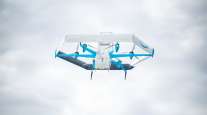UPS Drone Test Fosters Optimism

This story appears in the Oct. 3 print edition of Transport Topics.
Drone technology is evolving so rapidly that companies such as UPS Inc., FedEx Corp. and Amazon.com could be using them within five years, according to industry watchers.
UPS is among the latest to publicize its efforts, when it conducted a test with robot-maker CyPhy Works on Sept. 22 to deliver an inhaler from Beverly, Massachusetts, to Children’s Island, a 3-mile flight. UPS is working with CyPhy to gather information about drone uses and capabilities.
The Atlanta-based carrier wouldn’t disclose the size of the investment with CyPhy but said it invests more than $1 billion in technology annually.
“UPS believes unmanned aircraft systems technology could help access hard-to-reach locations for humanitarian relief efforts and for specific commercial deliveries,” said John Dodero, UPS vice president of industrial engineering. “Our recent drone test flight is a great example of a commercial urgent delivery to a hard-to-reach location.”
He insisted the technology would enhance its service but not replace the commercial fleet or drivers doing regular routes in populated towns and cities.
UPS ranks No. 1 on the Transport Topics Top 100 list of the largest U.S. and Canadian for-hire carriers.
“UPS drivers are a key part of the success of the company. UPS uniformed employees are central to our business, and they remain a vital connection to our customers,” Dodero said. “Likewise, the vehicles we operate, including more than 104,000 ground vehicles and more than 500 company-owned and leased jet aircraft, are critical and valuable parts of our global transportation network.”
Helen Greiner, CyPhy’s founder and chief technology officer, said that the drones would be ideal for shore-to-island deliveries or during natural disasters when destinations are inaccessible to trucks. However, she hopes that drones eventually will become commonplace in other locations.
“The closest point between any two locations is as the drone flies. It gives you a cost-effective, quicker way to get a delivery done,” Greiner said. “If you’re going to load up a truck, that’s a very efficient way to get many packages to multiple destinations, but if someone wants something extremely fast, drones can solve that.”
Amazon.com founder Jeff Bezos said on the CBS News program “60 Minutes” in 2013 that drones were integral to the company’s future. Amazon also has set up a website to advertise the Amazon Prime Air drone. However, the company can’t proceed with deliveries until the Federal Aviation Administration lifts a provision in the rules passed last month that requires drones to remain within eyesight of the operator at all times. Companies such as Amazon.com pushed for “beyond line-of-sight” service.
“If you’re flying a drone and it passes over a hill or pops behind a building, you are now violating FAA rules,” Arthur Holland Michel, co-director of the Center for the Study of the Drone at Bard College, said during a forum at the Cato Institute on Sept. 27. “Obviously, if you’re hoping to deliver iPad cases via Amazon, that rule is going to make it a nonstarter.”
He added that there is a good chance that the FAA will accede to the delivery companies, but he wouldn’t speculate as to when. Others believe it could be soon.
“My best guess would be 3½ years before we start to see widespread deliveries. Google is already doing it. Amazon is doing it. There are test programs at Virginia Tech,” said Justin Towles, a vice president at the American Association of Airport Executives. “I don’t think we’re far off. We see the path, it’s just a matter of getting there.”
“For remote locations, we can start doing that sometime next year,” Greiner added. “For the general population, quick-time deliveries, more like 2020, but we would need to overcome the regulatory hurdles and airspace issues.”
FedEx Corp., which ranks No. 2 on the for-hire TT100, is also researching how it could use drones. However, it has been more tight-lipped about the details. CEO Fred Smith answered a question about the topic on a Sept. 20 conference call with industry analysts.
He said that, in terms of unmanned aerial vehicles, the company has five separate work streams in both aviation and automated vehicles. “The difference with us and a lot of other people, we just prefer to keep working those issues and tell you about them when they make a meaningful difference in the company,” he said.
At the same time UPS was testing drones, Mercedes-Benz was presenting its Vision Van at the IAA Commercial Vehicles trade fair in Hanover, Germany. It was self-loading and lodged two drones on the roof that the company said could be used for lightweight residential deliveries.




